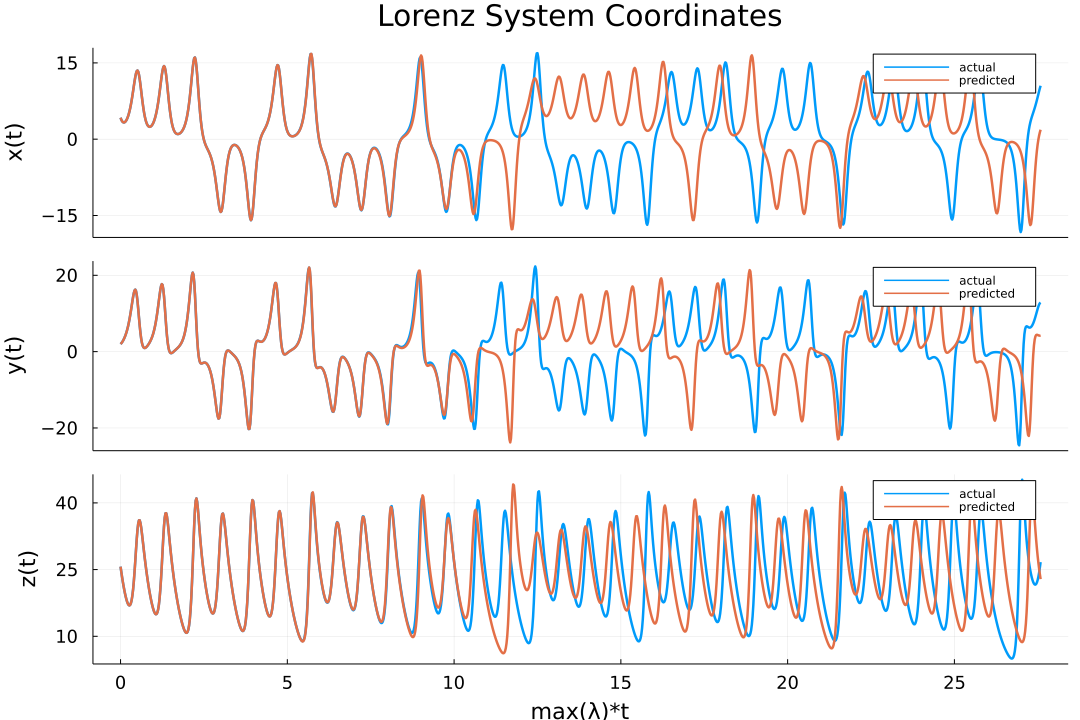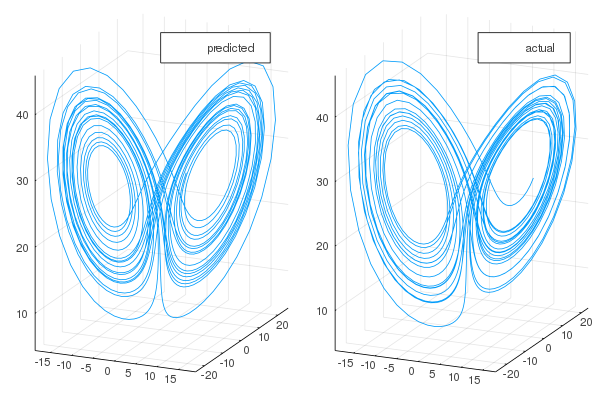I am receiving a MethodError when attempting to run the most basic example provided with ReservoirComputing.jl
The MethodError occurs when invoking ESN:
julia> esn = ESN(input_data;
reservoir = RandSparseReservoir(res_size, radius = 1.2, sparsity = 6 / res_size),
input_layer = WeightedLayer(),
nla_type = NLAT2())
ERROR: MethodError: no method matching size(::RecursiveArrayTools.DiffEqArray{Float64, 2, Vector{Vector{Float64}}, Vector{Float64}, Vector{Float64}, ODEFunction{true, SciMLBase.AutoSpecialize,
Full details including package and version numbers and terminal I/O is provided below.
I look forward to your feedback and guidance in resolving this issue!
nick@localhost-live:~$ julia
_
_ _ ()_ | Documentation: https://docs.julialang.org
() | () () |
_ _ | | __ _ | Type "?" for help, "]?" for Pkg help.
| | | | | | |/ ` | |
| | || | | | (| | | Version 1.9.4 (2023-11-14)
/ |_'|||_'_| | Official https://julialang.org/ release
|__/ |
julia> versioninfo()
Julia Version 1.9.4
Commit 8e5136fa297 (2023-11-14 08:46 UTC)
Build Info:
Official https://julialang.org/ release
Platform Info:
OS: Linux (x86_64-linux-gnu)
CPU: 12 × AMD Ryzen 5 1600 Six-Core Processor
WORD_SIZE: 64
LIBM: libopenlibm
LLVM: libLLVM-14.0.6 (ORCJIT, znver1)
Threads: 1 on 12 virtual cores
(@v1.9) pkg> status
Status ~/.julia/environments/v1.9/Project.toml
[1dea7af3] OrdinaryDiffEq v6.63.0
[91a5bcdd] Plots v1.39.0
[731186ca] RecursiveArrayTools v3.1.0
[7c2d2b1e] ReservoirComputing v0.9.5
julia> using ReservoirComputing, OrdinaryDiffEq
julia> #lorenz system parameters
u0 = [1.0, 0.0, 0.0]
3-element Vector{Float64}:
1.0
0.0
0.0
julia> tspan = (0.0, 200.0)
(0.0, 200.0)
julia> p = [10.0, 28.0, 8 / 3]
3-element Vector{Float64}:
10.0
28.0
2.6666666666666665
julia> #define lorenz system
function lorenz(du, u, p, t)
du[1] = p[1] * (u[2] - u[1])
du[2] = u[1] * (p[2] - u[3]) - u[2]
du[3] = u[1] * u[2] - p[3] * u[3]
end
lorenz (generic function with 1 method)
julia> #solve and take data
prob = ODEProblem(lorenz, u0, tspan, p)
ODEProblem with uType Vector{Float64} and tType Float64. In-place: true
timespan: (0.0, 200.0)
u0: 3-element Vector{Float64}:
1.0
0.0
0.0
julia> data = solve(prob, ABM54(), dt = 0.02)
retcode: Success
Interpolation: 3rd order Hermite
t: 10001-element Vector{Float64}:
0.0
0.02
0.04
0.06
0.08
0.1
0.12000000000000001
0.14
0.16
0.18
⋮
199.84000000002843
199.86000000002844
199.88000000002845
199.90000000002846
199.92000000002847
199.94000000002848
199.9600000000285
199.9800000000285
200.0
u: 10001-element Vector{Vector{Float64}}:
[1.0, 0.0, 0.0]
[0.8680136241599999, 0.5116114289171798, 0.00464843405046073]
[0.846922029853721, 0.9721624694997062, 0.016723754482887952]
[0.9127463182632621, 1.4365930707725014, 0.03638911365118479]
[1.0547161536343206, 1.9492406388218464, 0.06682954770912672]
[1.27153139719415, 2.5500972526141688, 0.11416945073599366]
[1.569344101287243, 3.2792182194088135, 0.18865896722509617]
[1.9607159493604909, 4.179979661504116, 0.30675850312612357]
[2.4642887133184064, 5.301306601644064, 0.4946463038435349]
[3.1048014427360577, 6.698665411076851, 0.7936722317742436]
⋮
[-12.712535028050192, -7.991920612082245, 36.96745201041986]
[-11.636377668987166, -5.691148385936144, 36.66624998028994]
[-10.372587430370148, -3.7766460900344607, 35.77093362370175]
[-9.034083394619811, -2.325994687676812, 34.4844534202631]
[-7.718171209563215, -1.3249744565922135, 32.98711594710444]
[-6.496311609072913, -0.7054966719917979, 31.41147109034457]
[-5.412475842259617, -0.3802159215457954, 29.84101721524591]
[-4.486956988649644, -0.26529770021033905, 28.320947150047015]
[-3.722463627032463, -0.2914952957436106, 26.87140831430775]
julia> shift = 300
300
julia> train_len = 5000
5000
julia> predict_len = 1250
1250
julia> #one step ahead for generative prediction
input_data = data[:, shift:(shift + train_len - 1)]
t: 5000-element Vector{Float64}:
5.9799999999999605
5.99999999999996
6.01999999999996
6.039999999999959
6.059999999999959
6.079999999999958
6.099999999999958
6.1199999999999575
6.139999999999957
6.159999999999957
⋮
105.79999999999609
105.81999999999609
105.83999999999608
105.85999999999608
105.87999999999607
105.89999999999607
105.91999999999607
105.93999999999606
105.95999999999606
u: 5000-element Vector{Vector{Float64}}:
[-9.903289241214775, -9.018088588651105, 29.81517777140388]
[-9.691839850827593, -8.473011482849701, 29.93605690750639]
[-9.420486660590333, -7.939065463718113, 29.90843259211291]
[-9.104880950241373, -7.4449797108850175, 29.742036297886404]
[-8.762474089642671, -7.01314735768699, 29.454019305573695]
[-8.410935717615619, -6.658702746055927, 29.06608913077009]
[-8.066811666191718, -6.389828805905225, 28.601842075390245]
[-7.744566849246501, -6.2089080639741825, 28.084693027483976]
[-7.456053443994025, -6.11406609169808, 27.53654671977279]
[-7.210360712173874, -6.1007246144663565, 26.977154921025395]
⋮
[12.518922134483173, 10.108387400259105, 34.677601864758]
[11.905676310941601, 8.232629715112148, 35.05977814254804]
[11.071914312382939, 6.472053614446601, 34.882263966926644]
[10.092017839786998, 4.960342280071891, 34.24498656635422]
[9.04494324433941, 3.7654618681658447, 33.275347750522876]
[8.001895218860973, 2.8967891643506336, 32.09636572944009]
[7.018825886840775, 2.3239810199099424, 30.808116692367136]
[6.13395766702855, 1.9972030630363637, 29.48232612752881]
[5.3690197189757916, 1.862732065250123, 28.165385874059083]
julia> target_data = data[:, (shift + 1):(shift + train_len)]
t: 5000-element Vector{Float64}:
5.99999999999996
6.01999999999996
6.039999999999959
6.059999999999959
6.079999999999958
6.099999999999958
6.1199999999999575
6.139999999999957
6.159999999999957
6.179999999999956
⋮
105.81999999999609
105.83999999999608
105.85999999999608
105.87999999999607
105.89999999999607
105.91999999999607
105.93999999999606
105.95999999999606
105.97999999999605
u: 5000-element Vector{Vector{Float64}}:
[-9.691839850827593, -8.473011482849701, 29.93605690750639]
[-9.420486660590333, -7.939065463718113, 29.90843259211291]
[-9.104880950241373, -7.4449797108850175, 29.742036297886404]
[-8.762474089642671, -7.01314735768699, 29.454019305573695]
[-8.410935717615619, -6.658702746055927, 29.06608913077009]
[-8.066811666191718, -6.389828805905225, 28.601842075390245]
[-7.744566849246501, -6.2089080639741825, 28.084693027483976]
[-7.456053443994025, -6.11406609169808, 27.53654671977279]
[-7.210360712173874, -6.1007246144663565, 26.977154921025395]
[-7.013953305940451, -6.162911685030047, 26.423996356199307]
⋮
[11.905676310941601, 8.232629715112148, 35.05977814254804]
[11.071914312382939, 6.472053614446601, 34.882263966926644]
[10.092017839786998, 4.960342280071891, 34.24498656635422]
[9.04494324433941, 3.7654618681658447, 33.275347750522876]
[8.001895218860973, 2.8967891643506336, 32.09636572944009]
[7.018825886840775, 2.3239810199099424, 30.808116692367136]
[6.13395766702855, 1.9972030630363637, 29.48232612752881]
[5.3690197189757916, 1.862732065250123, 28.165385874059083]
[4.732497640190652, 1.8723908301054109, 26.88478061861816]
julia> test = data[:, (shift + train_len):(shift + train_len + predict_len - 1)]
t: 1250-element Vector{Float64}:
105.97999999999605
105.99999999999605
106.01999999999605
106.03999999999604
106.05999999999604
106.07999999999603
106.09999999999603
106.11999999999603
106.13999999999602
106.15999999999602
⋮
130.7999999999931
130.81999999999312
130.83999999999313
130.85999999999314
130.87999999999315
130.89999999999316
130.91999999999317
130.93999999999318
130.9599999999932
u: 1250-element Vector{Vector{Float64}}:
[4.732497640190652, 1.8723908301054109, 26.88478061861816]
[4.22349538680031, 1.987820915806937, 25.655613923905776]
[3.8353316780542905, 2.181372263125947, 24.485767387745945]
[3.5584604091713943, 2.4351927068305277, 23.37943997904429]
[3.3826188986546626, 2.739600649501364, 22.339370937107052]
[3.2982766454142727, 3.0913593199467937, 21.368185196603726]
[3.2975239355256036, 3.492142131634464, 20.46924395963976]
[3.3745467566607004, 3.947276445140908, 19.647275341036046]
[3.5258121339502693, 4.464737468128744, 18.908963446114747]
[3.7500536807441187, 5.054297346775937, 18.263604797307796]
⋮
[5.667284334594522, 7.920044709382794, 21.837292439416736]
[6.128504560099492, 8.495628927065395, 21.64604924227314]
[6.616442143819489, 9.132648149983781, 21.6160067677496]
[7.1357622016914535, 9.812756425953655, 21.762471295222465]
[7.686353276111834, 10.510880836564114, 22.099963839944905]
[8.262833251743796, 11.193794316023716, 22.639394570288623]
[8.853950777066231, 11.819492971445888, 23.384189012804384]
[9.442118229459183, 12.338166583539232, 24.3255347922894]
[10.003421378477109, 12.695609055900354, 25.43743234339266]
julia> res_size = 300
300
julia> esn = ESN(input_data;
reservoir = RandSparseReservoir(res_size, radius = 1.2, sparsity = 6 / res_size),
input_layer = WeightedLayer(),
nla_type = NLAT2())
ERROR: MethodError: no method matching size(::RecursiveArrayTools.DiffEqArray{Float64, 2, Vector{Vector{Float64}}, Vector{Float64}, Vector{Float64}, ODEFunction{true, SciMLBase.AutoSpecialize, FunctionWrappersWrappers.FunctionWrappersWrapper{Tuple{FunctionWrappers.FunctionWrapper{Nothing, Tuple{Vector{Float64}, Vector{Float64}, Vector{Float64}, Float64}}, FunctionWrappers.FunctionWrapper{Nothing, Tuple{Vector{ForwardDiff.Dual{ForwardDiff.Tag{DiffEqBase.OrdinaryDiffEqTag, Float64}, Float64, 1}}, Vector{ForwardDiff.Dual{ForwardDiff.Tag{DiffEqBase.OrdinaryDiffEqTag, Float64}, Float64, 1}}, Vector{Float64}, Float64}}, FunctionWrappers.FunctionWrapper{Nothing, Tuple{Vector{ForwardDiff.Dual{ForwardDiff.Tag{DiffEqBase.OrdinaryDiffEqTag, Float64}, Float64, 1}}, Vector{Float64}, Vector{Float64}, ForwardDiff.Dual{ForwardDiff.Tag{DiffEqBase.OrdinaryDiffEqTag, Float64}, Float64, 1}}}, FunctionWrappers.FunctionWrapper{Nothing, Tuple{Vector{ForwardDiff.Dual{ForwardDiff.Tag{DiffEqBase.OrdinaryDiffEqTag, Float64}, Float64, 1}}, Vector{ForwardDiff.Dual{ForwardDiff.Tag{DiffEqBase.OrdinaryDiffEqTag, Float64}, Float64, 1}}, Vector{Float64}, ForwardDiff.Dual{ForwardDiff.Tag{DiffEqBase.OrdinaryDiffEqTag, Float64}, Float64, 1}}}}, false}, LinearAlgebra.UniformScaling{Bool}, Nothing, Nothing, Nothing, Nothing, Nothing, Nothing, Nothing, Nothing, Nothing, Nothing, Nothing, typeof(SciMLBase.DEFAULT_OBSERVED), Nothing, SymbolicIndexingInterface.SymbolCache{Nothing, Nothing, Nothing}}}, ::Int64)
Closest candidates are:
size(::Union{LinearAlgebra.QR, LinearAlgebra.QRCompactWY, LinearAlgebra.QRPivoted}, ::Integer)
@ LinearAlgebra ~/.julia/juliaup/julia-1.9.4+0.x64.linux.gnu/share/julia/stdlib/v1.9/LinearAlgebra/src/qr.jl:581
size(::Union{LinearAlgebra.QRCompactWYQ, LinearAlgebra.QRPackedQ}, ::Integer)
@ LinearAlgebra ~/.julia/juliaup/julia-1.9.4+0.x64.linux.gnu/share/julia/stdlib/v1.9/LinearAlgebra/src/qr.jl:583
size(::Union{LinearAlgebra.Cholesky, LinearAlgebra.CholeskyPivoted}, ::Integer)
@ LinearAlgebra ~/.julia/juliaup/julia-1.9.4+0.x64.linux.gnu/share/julia/stdlib/v1.9/LinearAlgebra/src/cholesky.jl:513
...
Stacktrace:
[1] ESN(train_data::RecursiveArrayTools.DiffEqArray{Float64, 2, Vector{Vector{Float64}}, Vector{Float64}, Vector{Float64}, ODEFunction{true, SciMLBase.AutoSpecialize, FunctionWrappersWrappers.FunctionWrappersWrapper{Tuple{FunctionWrappers.FunctionWrapper{Nothing, Tuple{Vector{Float64}, Vector{Float64}, Vector{Float64}, Float64}}, FunctionWrappers.FunctionWrapper{Nothing, Tuple{Vector{ForwardDiff.Dual{ForwardDiff.Tag{DiffEqBase.OrdinaryDiffEqTag, Float64}, Float64, 1}}, Vector{ForwardDiff.Dual{ForwardDiff.Tag{DiffEqBase.OrdinaryDiffEqTag, Float64}, Float64, 1}}, Vector{Float64}, Float64}}, FunctionWrappers.FunctionWrapper{Nothing, Tuple{Vector{ForwardDiff.Dual{ForwardDiff.Tag{DiffEqBase.OrdinaryDiffEqTag, Float64}, Float64, 1}}, Vector{Float64}, Vector{Float64}, ForwardDiff.Dual{ForwardDiff.Tag{DiffEqBase.OrdinaryDiffEqTag, Float64}, Float64, 1}}}, FunctionWrappers.FunctionWrapper{Nothing, Tuple{Vector{ForwardDiff.Dual{ForwardDiff.Tag{DiffEqBase.OrdinaryDiffEqTag, Float64}, Float64, 1}}, Vector{ForwardDiff.Dual{ForwardDiff.Tag{DiffEqBase.OrdinaryDiffEqTag, Float64}, Float64, 1}}, Vector{Float64}, ForwardDiff.Dual{ForwardDiff.Tag{DiffEqBase.OrdinaryDiffEqTag, Float64}, Float64, 1}}}}, false}, LinearAlgebra.UniformScaling{Bool}, Nothing, Nothing, Nothing, Nothing, Nothing, Nothing, Nothing, Nothing, Nothing, Nothing, Nothing, typeof(SciMLBase.DEFAULT_OBSERVED), Nothing, SymbolicIndexingInterface.SymbolCache{Nothing, Nothing, Nothing}}}; variation::Default, input_layer::WeightedLayer{Float64}, reservoir::RandSparseReservoir{Float64, Float64}, bias::NullLayer, reservoir_driver::RNN{typeof(NNlib.tanh_fast), Float64}, nla_type::NLAT2, states_type::StandardStates, washout::Int64, matrix_type::Type)
@ ReservoirComputing ~/.julia/packages/ReservoirComputing/ptuHU/src/esn/echostatenetwork.jl:112
[2] top-level scope
@ REPL[17]:1
julia>










